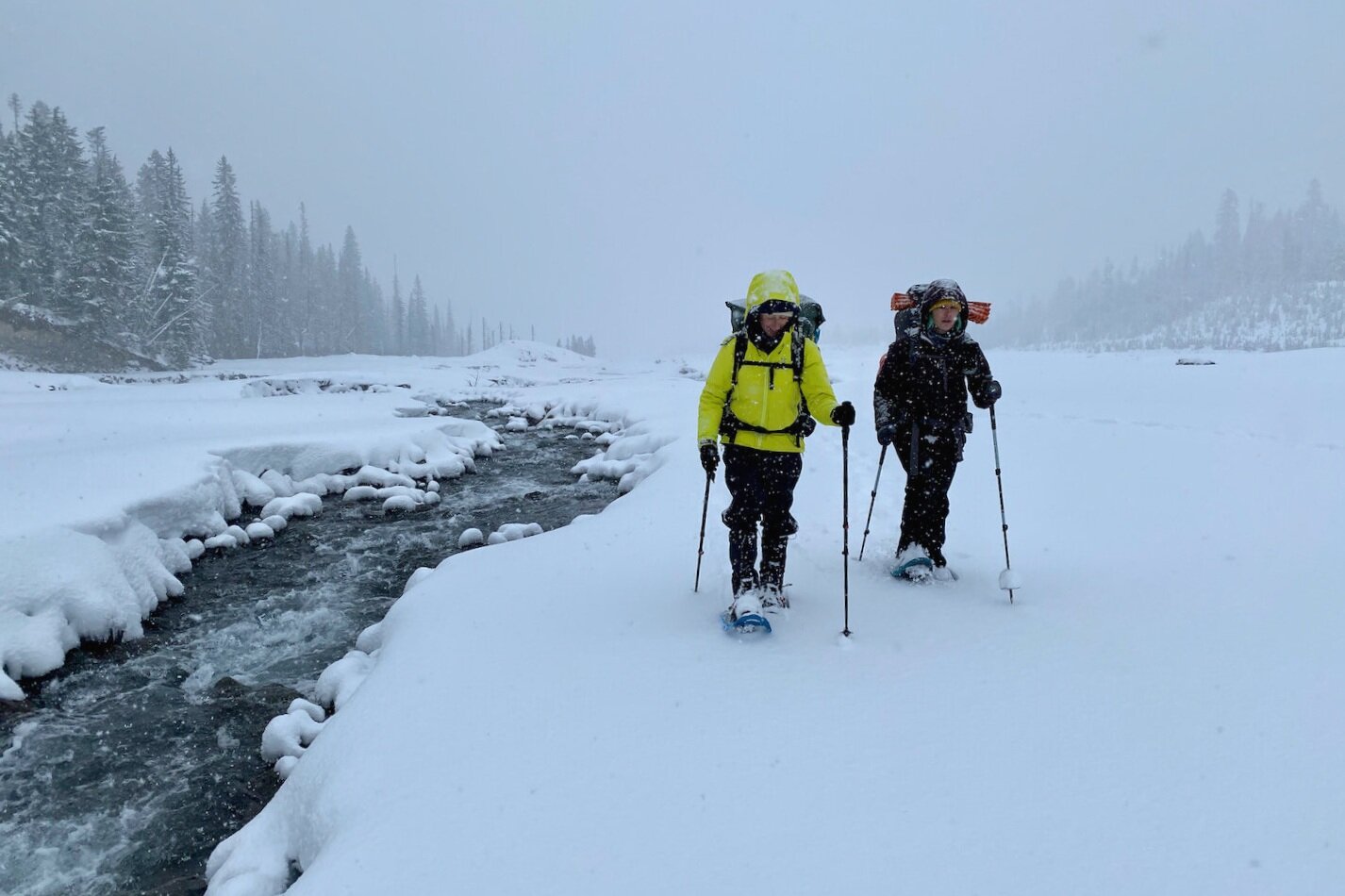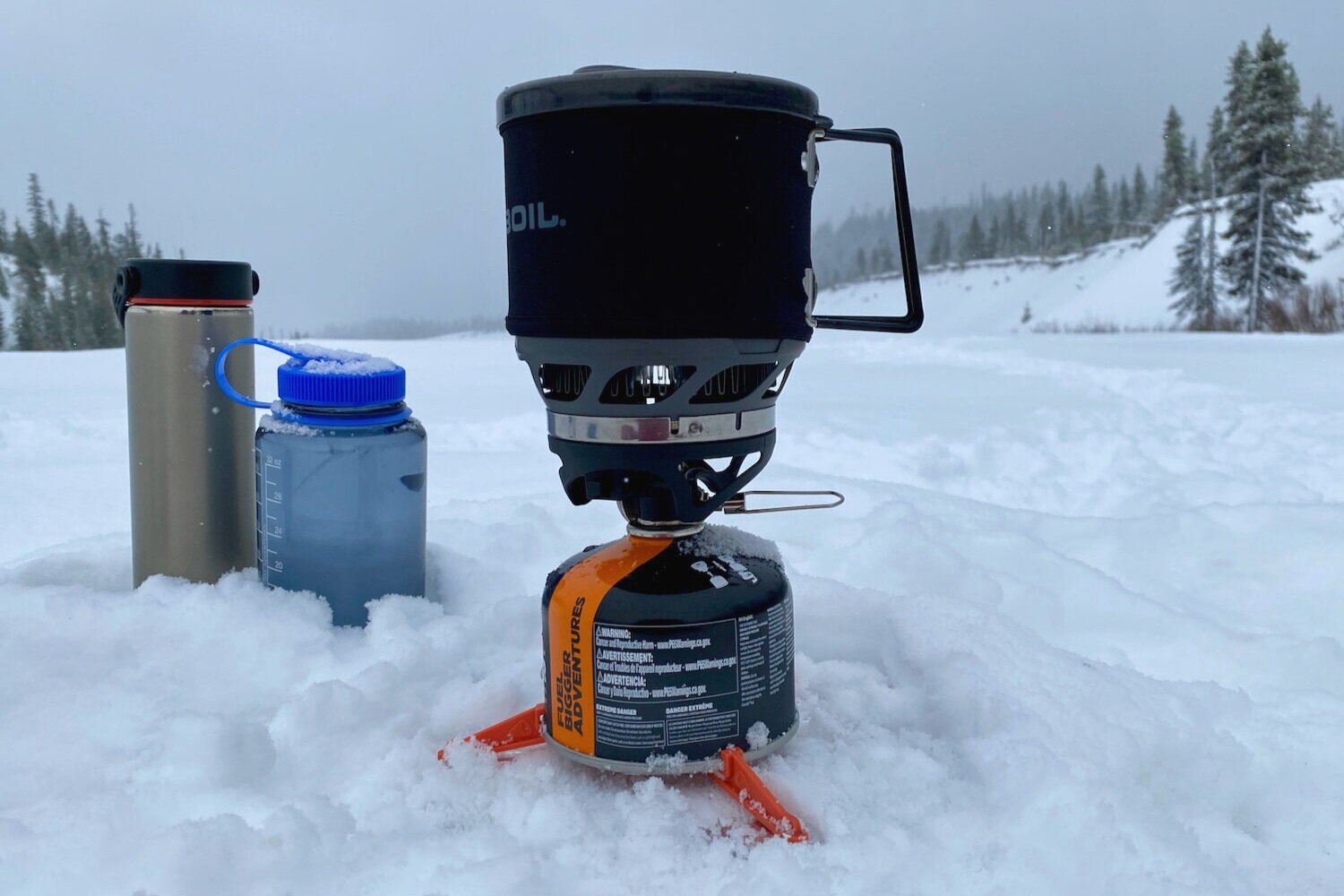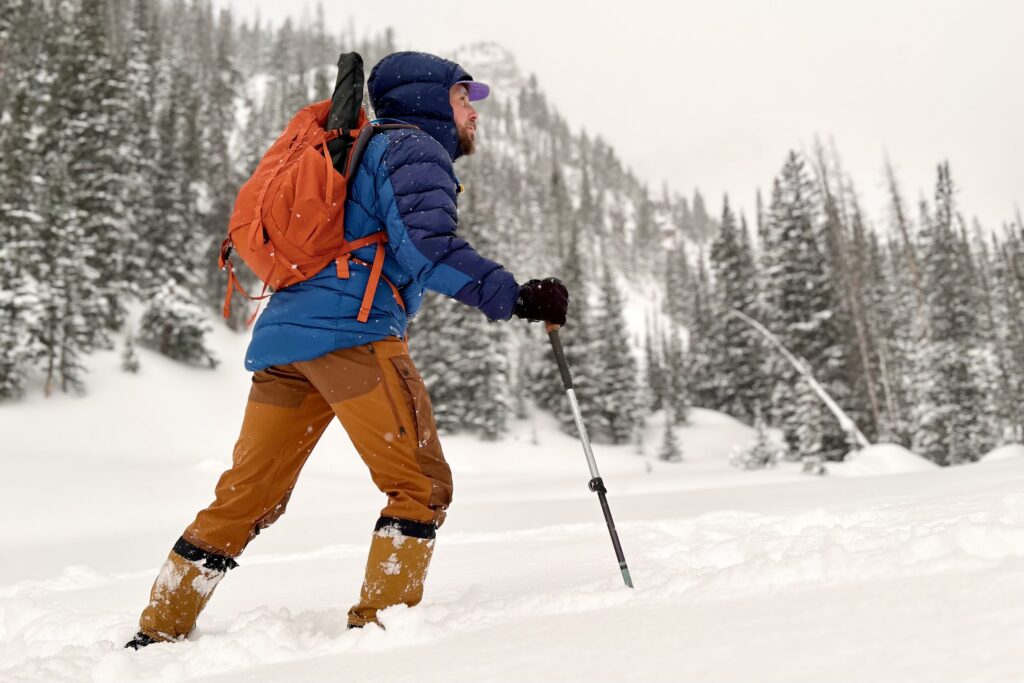
Winter camping is a unique experience that creates life-long memories. We love snowshoeing, building camps, and gathering with friends in our snow kitchens over steaming food and hot drinks. Nothing is more magically pristine than unzipping your tent to an alpine sunrise in the winter. Hiking in the winter means spotting tracks of a snowshoe hare, lynx, wolves, mountain lions, goats, or maybe even wolverine. It means glittering frost clinging to pine needles as they reach for the stars. It often means no competitive permits and no crowds.
Winter camping might seem difficult at first, but it’s actually pretty simple and surprisingly comfortable with the right gear. We hope these tips inspire you to get out and try winter camping for yourself. Also, don’t miss our complete winter camping checklist to help you pack. Let us know how it goes!
1. Watch the Forecast
It’s important to pay close attention to the weather and plan around it for a safe and successful winter camping experience. We look for a string of high-pressure days with clear skies, low wind, or light snow. Sub-freezing temperatures can be great if you have the right equipment, but knowing the limits of your gear is key so you can set yourself up for success. Monitor the temperature, wind, and precipitation as your trip dates approach. If conditions look too intense, it may be best to reassess or postpone your trip.
In addition to weather forecasts, be sure to check the avalanche forecasts from avalanche.org in your region. See more on this below in tip #10: Be Avalanche Aware.

2. Base Camp & Keep Trips Short
It’s best to keep daily mileage goals short for winter camping trips, even if you’re in good shape. Trekking through the snow saps your energy quickly, and you’ll need to save some pep to build your camp when you get there. It’s usually pretty easy to find a beautiful, snowy place to set up a dispersed camp within a few miles in National Forests and wilderness areas. It’s also smart to keep the length of your trip short if you’re new to winter camping. One or two nights out is a good test because damp clothing and gear gets tougher to manage the longer you’re out in the elements. We like to set up a base camp and adventure from there when we know a high-pressure system is in the forecast.

3. Thermoregulate
Thermoregulation is all about awareness and managing your body’s temperature proactively. Food, water, clothing, shelter, and physical activity are all tools to increase your heat production and control your body temperature. Wear performance clothing made with materials that dry quickly (like synthetics and wool) and layer to add or remove items easily when your activity level changes. If you’re overdressed while active, you’ll overheat quickly, so dress accordingly to avoid sweating. Warm and sweaty quickly becomes cold and wet, which is a bad combo in the backcountry.
Another tool for moisture management is slowing your pace to avoid sweating. It might feel like a crawl, but that turtle-like pace will keep you dryer and energized for your entire journey. We also pack a spare base layer in our day pack to swap out if we get sweaty on a climb.
If you’re cold, it’s time to add a layer of clothing, get moving, or fuel your body with food or a hot drink. For more information on layering, head over to our Backpacking and Hiking Clothing 101 article.

4. Know the Signs of Hypothermia & Frostbite
Staying safe and comfortable in cold conditions is easy, but it requires you to remain aware of what your body is feeling. Hypothermia is very serious and occurs when the body’s core is losing heat faster than it can produce it.
Progressing signs of hypothermia include uncontrollable shivering, loss of coordination, or personality changes. If that’s happening, it’s time to get them to a shelter to change out of wet clothing and hop into a warm sleeping bag. Stay close to your hiking partner and keep communicating so you can tell when someone starts getting grumpy, quiet, or disoriented.
For our friends with cold fingers and toes, frostbite is a serious concern and you’ll want to stay ahead of it. If you have poor circulation, Raynaud’s, or previous frostbite damage and plan on spending a lot of time on the snow, heated socks, footbeds, and gloves or mittens are game changers. Mittens keep your hands warmer but you lose a lot of dexterity. Keep some hand warmers (disposable or rechargeable) in your kit, and an emergency space blanket. Should things head south quickly, you’re going to use every tool you’ve got to stave off hypothermia.

5. Check Your Gear’s Temperature Ratings
Since you’ll be camping on top of the snow, it’s critical to have an adequately warm sleeping pad and sleeping bag on winter camping trips. Check out our gear guides to the best sleeping pads and sleeping bags to see what we love and use on winter trips.
Most sleeping bags use EN or ISO ratings, standardized systems that keep temperature ratings consistent across the industry. The number listed with most sleeping bags (example: Magma 15) is the lower limit, which is the temperature a warm-sleeper will likely still be comfortable. We find that the comfort rating – the temperature a cold-sleeper will typically still be comfortable – gives a more realistic idea of how a bag will perform. If no comfort rating is listed, we usually estimate it to be 10-15° above the lower limit.
Choosing the right temperature rating isn’t an exact science, but looking at these numbers is a good place to start. We like using the REI Magma 15 or Western Mountaineering Versalite 10 sleeping bags with the Therm-a-Rest XTherm sleeping pad for our winter trips. Add a close-cell foam pad like the NEMO Switchback for even better insulation off the ground.
Keep in mind that the “puff” in your puffy jacket and sleeping bag (aka loft) keeps you warm and insulated. Over time, down loses its loft from getting dirty, holes and tears that leak feathers, or too much time in a compression bag. Just because that zero-degree down sleeping bag from your dad worked 20 years ago doesn’t mean it has the same “oompf” as it used to. Test your gear before trusting your life with it!

6. Warm Up Your Sleep System
Wearing a down jacket with a hood inside your sleeping bag will significantly boost your warmth. You can also sleep in base layers, down pants, a warm hat, and gloves. Even your raincoat and pants help should things get truly dire. If your feet tend to get cold at night, down booties are a real game changer. We love Feathered Friends Down Booties because they’re super warm and have a removable weather-resistant shell, so you can wear them around camp and in your bag. For particularly chilly trips, we also bring the NEMO Switchback foam pad to throw under our insulated air pad for extra insulation.
See our gear guides to warm-up your packing list:
And down isn’t just for sleeping bags and jackets. We are obsessed with these Mountain Hardwear down pants and Norrona down knickers for standing around in biting temps.

7. Insulate Off the Ground During Downtime
A lightweight closed-cell foam sleeping pad, like the NEMO Switchback, can be used in conjunction with an air pad to maximize the warmth of your sleep system. It’ll also come in handy when you’re hanging outside your tent. Standing, sitting, and kneeling on a foam sleeping pad or sit pad avoids direct contact with the snow and prevents heat loss.

8. Use a 4-Season Tent
Winter camping requires a strong tent with stout poles and thicker fabric that can withstand strong winds and the weight of a snow load. If the forecast is clear, you can get away with using a more rugged 3-season tent, but you’ll be more snug and secure with a 4-season. If snow is in the forecast, it can vary from feather-weight crystals to concrete blocks. Even a thin layer of wet, heavy snow is enough to buckle many 3-season backpacking tents. Our comprehensive, tested, and reviewed gear guide to the best 4-season tents is a great place to start if you’re looking for a 4-season tent.
4-season tents are usually heavier, have less headroom, and aren’t as breathable as 3-season tents, but the superior durability and protection they provide are worth the tradeoff in harsh winter conditions. We recommend the Mountain Hardwear Outpost 2 and Trango 2, which have a great balance of weight, strength, and weather protection.
If you’re looking for an ultralight tent that can be used year-round, the Hyperlite Mountain Gear Ultamid 2 (1 lb 2 oz) is a great option, though it takes a little practice to set up since it’s not freestanding. Black Diamond also has a beloved pyramid tent, the Mega Mid (2 lb 7 oz), that uses a ski/trekking pole to keep your pack weight to a minimum. There is no floor on either of these, so this is true on snow camping. They are surprisingly warm and loved by the backcountry skiing community.

9. Keep Important Things Above Freezing
The temperature drops dramatically once the sun goes down, leaving drinking water, wet clothing, boots, and liquids (sunscreen, etc.) susceptible to freezing. Batteries also tend to function poorly in sub-freezing temperatures, so you’ll want to keep your electronics (like your phone, power bank, and headlamp) in a warm pocket close to your body to prevent them from becoming useless. We keep small items under our hats or in inner jacket pockets during the day, and use trash bags or waterproof stuff sacks (see Best Stuff Sacks Guide) to store important wet gear close to our bodies in our sleeping bags at night. You can also tuck damp items, like socks and liner gloves, between your skin and your base layers to dry out. This is slightly uncomfortable, but it’s much better than putting on frozen clothes in the morning!
Our favorite cold-hardy powerbanks are on our gear guide to the best power banks. Many headlamps are cold-weather worthy, and our gear guide to the best headlamps has some of the best winter weather performers, like the Fenix HM50R V2.0.

10. Be Avalanche Aware
Avalanches are masses of snow that flow, slide or tumble down a slope. They’re one of the biggest threats to winter backcountry travelers. Do not camp in or below avalanche terrain, in areas that connect to avalanche terrain, or in terrain traps. Avalanche.org is a great resource to learn more about identifying avalanche terrain. If you haven’t already, but you love getting into the mountains in the winter, consider taking an avalanche safety course. They’re fun, super informative, and make you a better winter backcountry companion. The American Avalanche Association is a great resource for information on recreational safety courses and clinics across the nation.
It’s important to know how to identify red flags that indicate avalanching is possible. You also want to be able to identify avalanche terrain, including start and stop zones, slope angle, and terrain traps, so you can avoid putting yourself and others in a dangerous situation.
That said, avalanches occur at a slope greater than 30 degrees. So, if you’re just starting winter travel and camping, you can gain some experience without worrying about avalanche danger by traveling and camping in flat or rolling terrain. Just make sure you aren’t in a slide path. Dry avalanches travel an average of 80 miles an hour, and large, fully-developed avalanches can run over flat areas and valley bottoms.
Sure, understanding the avalanche terrain and warning signs when moving through snow-covered mountains is essential to mitigating risk. Equally important is carrying rescue gear (transceiver, shovel, probe) and being trained and practiced in snow burial rescue. Take a rescue course and get into the snowy mountains with more awareness and confidence.
Finally, take a look at your map before you head out. Even if there isn’t avalanche danger, steep, icy slopes can also be fatal. If your route traverses steep terrain, you should carry an ice axe like C.A.M.P’s Corsa and know how to self-arrest. Our tutorial on crossing snow and self-arresting is a great place to refresh your winter-savvy travel skills.

11. Bring a Shovel
Your shovel isn’t just a rescue tool. A lightweight snow shovel like the Black Diamond Transfer Snow is one of the most essential items for winter camping. It can be used to level and pack tent sites, build a snow shelter, and create a group hangout area to cook and gather in. It can get pretty fun to make a kitchen complete with benches, shelves, and table tops. The blade of your shovel can also be used as a platform to stabilize your stove. The sky’s the limit when it comes to designing your snow camp, and it’s a lot of fun to build elaborate camps as a group with features like a cooking area with a counter and a seating area with a wind block.

12. Wear Sun-Pro
Don’t underestimate how powerful the sun is, even during the winter. The sun can be extremely intense at high elevation, and it’s magnified as it reflects off the bright, white snow. Sunburns and eye injuries are common pitfalls of winter adventures, and the damage can last a lifetime. Have you ever experienced sunburnt nostrils? We don’t recommend it.
Thankfully, these hazards are easy to prevent with a bit of diligence. Apply a high-SPF sunscreen to your face, lips, neck, jaw/chin, and any exposed skin every day. Protect your peepers with quality sunglasses, preferably some with coverage at the sides. If you don’t have good glacier glasses like Julbo’s Montebianco 2 Spectron 4, a cheap alternative to block out the side is to tape duct tape folds on the arms of your glasses.

13. Eat, Drink & Be Merry
A hydrated and well-fed body is far better at staying warm. And, you’ll be burning a ton of calories while winter camping, so it’s a great time to indulge in your favorite rich foods. Keep your metabolism firing on all cylinders by eating plenty of snacks throughout the day and chasing them down with several liters of water. Our Best Energy Bars Guide is chock full of nutrient and calorie dense pocket snacks to keep your fire fueled.
A hearty dinner and a high-calorie snack at bedtime will help keep you nice and toasty. Just remember, food weight adds up quickly, so be choosy about what you bring. Check out our Best Trail Food Guide for all the meal-planning tips you could ever need. If you tend to get cold easily, sipping warm beverages will warm you from the inside out. Consider bringing an insulated water bottle (see CleverHiker’s 10 Best Water Bottles article), like the lightweight Hydroflask, and plenty of stove fuel so you can keep the hot drinks flowing. Learn which stoves work the best in the snow on our Winter Camping Checklist page.

14. Snuggle Up With a Hot Water Bottle
A plastic water bottle with a screw-top lid, like a Nalgene, makes an excellent space heater for your sleeping bag. Boil a liter of water, pour it in, and you’ve got a new winter camping snuggle buddy. Just make sure your bottle is heat-resistant, and always test the lid for leaks before you get it anywhere near your sleep sack. Place hot water bottles in strategic areas where deep blood vessels pass close to the surface of the skin, such as the groin, hands, feet, or armpits for rapid warming. Make sure your water bottle is BPA-free, so you can drink the water in the morning without harmful chemical leaching.

15. Keep the Stoke High
A positive outlook and a sense of humor make hiking in the winter much more enjoyable. You might be a bit uncomfortable sometimes, but challenging trips tend to be some of the most memorable. An extra dose of enthusiasm will go a long way to lifting you and your campmates’ spirits. If you’re struggling to stay warm, remember that you can always adjust your clothing, get moving, take a break to make a hot beverage, have an impromptu dance party, or hop in your sleeping bag.
Keeping the good vibes up also means being honest and communicative with your travel companions. Letting your team know you can’t feel your toes doesn’t bring the vibe down, but silently moping about it does. Keep it real, and you’ll all have a great time. Let us know how it goes!















